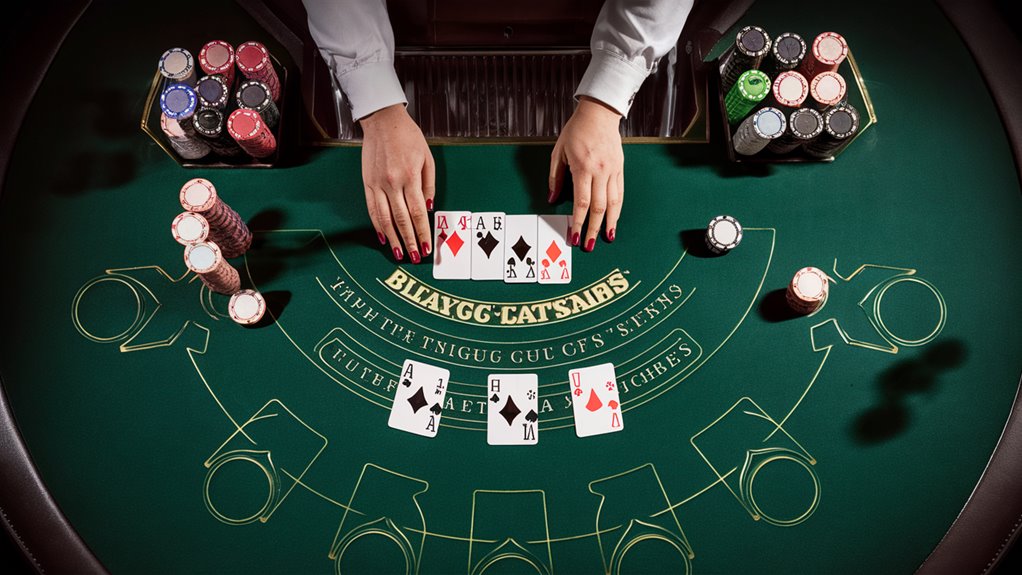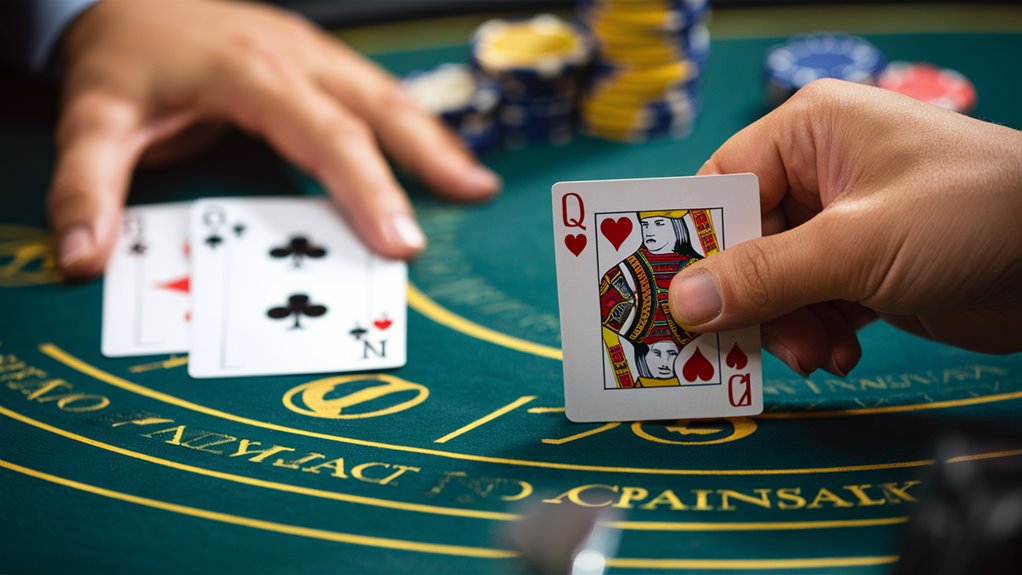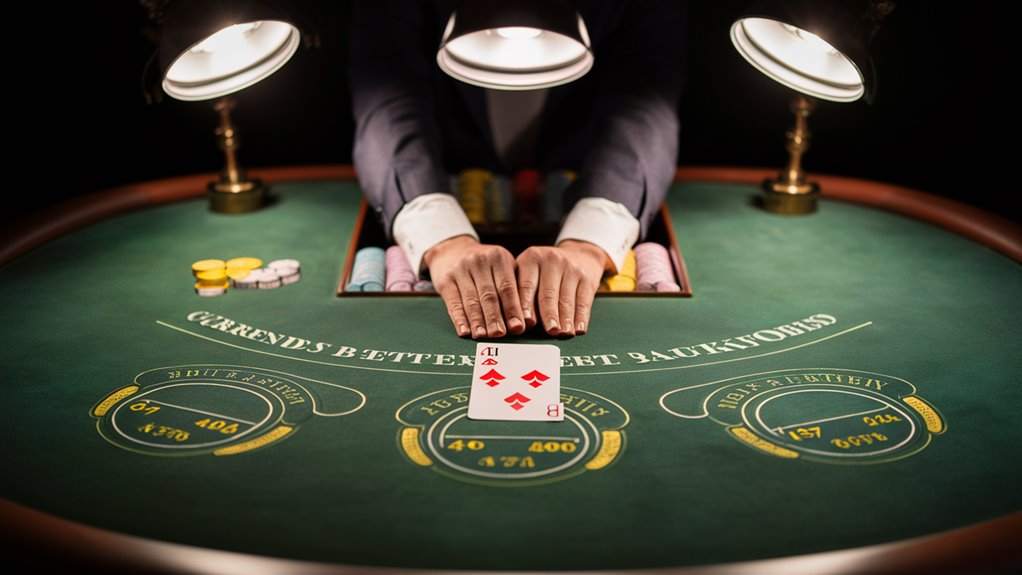
Blackjack Tips: How to Win Against the Dealer

Key Math to Win
To know basic blackjack strategy, learn key math choices that boost your win chances against the dealer. Let’s look at plays that can cut the strong house edge to 0.5%.
Choices with Hard Hands
- Hit on hard 12-16 when the dealer has 7 or more
- Stand on hard 12-16 if the dealer shows weak cards (4-6)
- Always stand on hard 17 or more
When to Split and Double
- Split Aces and 8s any time
- Double down on 11 with any dealer card
- Double soft 13-18 versus dealer’s 3-6
- Hit soft 18 if dealer has 9, 10, or Ace
Money Tips
- Keep 100x your bet as full bank
- Not more than 2% risk each hand
- Bet based on each upside
- Betting While Traveling
- Keep track to shape bets better
These test-backed blackjack basics set you up for bigger plays. Grasp these before moving to more hard counting and bet ways.
What Dealer Shows Matters
The Dealer’s Key Card in Blackjack
The Upcard’s Big Role
The dealer’s upcard, the card you see, is a key math sign in blackjack ways. This one card hints at likely ends and shapes your best moves.
On Odds and Bust Risks
Each card shows chances of bust that sharp players should know:
- A dealer with 6 might bust 42% of the time
- A dealer with 10 may only bust 21% of the time
- Weak cards (4,5,6) up odds to bust
- Strong cards (7-Ace) cut these odds
How It Changes Your Play
The dealer’s shown card directs smart plays for hard hands (12-16):
- Stand against weak cards, it can pay off
- With tough dealer cards, adjust wisely
- Math tells when to hit or stay
How Often Dealer Wins or Hits
Odds for dealer plays:
- Ace shown: 37% chance of smooth blackjack
- Strong cards: 66% chance of 17 or more
- These rates shape when to insure
- Odds help plan double downs
Knowing this math gives players a sound edge, using stats not just gut.
Hard Hand Moves
Pro Tips on Hard Hand Plays in Blackjack
Hard Hand Basics
Key hard hand moves need sharp math with your total and the dealer’s shown card, making you more likely to win.
What to Do with Hard 12-16
With hard hands from 12-16, best plan says hit if dealer shows a 7 or more. This bold way helps you as the dealer could end up with a strong hand.
For hard 12, best play switches to stand if the dealer’s cards are 4, 5, or 6, using their high chance to go bust.
On Strong Hard Hands (17+)
Hard hands 17 or more mean you should stand every time, no matter the dealer’s card. The chance of a bust beats possible gains from a hit, a key base rule.
For Low Hard Hands (Below 12)
For hard hands under 12, hitting is your only good move. Such low hands can’t bust with one more card, urging bold play.
Main Choice: Hard 16 vs Dealer’s 10
The hard 16 against a dealer’s 10 is a top choice spot in blackjack. Though many think to stand, math shows hitting is a hair better, even if losing the hand is likely either way.
Playing Soft Hands
Winning with Soft Hand Plays in Blackjack
Know Soft Hands
A soft hand in blackjack holds an Ace that can be 1 or 11, giving players a big stat plus.
This bonus lets you make plays not possible with hard hands.
Smart Ways to Play
Go bold with soft hands as you can’t bust with the first hit.
The best math-backed moves are:
- Double down on soft 13-15 if dealer shows 5-6
- Double down on soft 16-18 if dealer has 3-6
- Hit soft 18 if dealer has 9, 10, or Ace
Why It Pays Off
The key idea in soft hand strategy is using the Ace’s two values to stop a bust.
This safety turns risky moves into chances to win, as the Ace stops you from going over 21.
It Cuts House Edge
The right soft hand moves can cut the house edge by 0.13% over safe plays.
This math perk makes mastering soft hands a must for those who play a lot and want to up their game.
When to Split Pairs
Splitting Pairs for More Wins in Blackjack

Must-Know Rules on Splitting for More Wins
Valuable Pairs
Always split Aces and 8s no matter the dealer’s card.
Splitting Aces starts two strong hands with chances at blackjack, while 8s change a weak 16 into two better spots.
Medium Pairs
Split 2s, 3s, and 7s if the dealer shows 2 through 7.
Split 6s versus dealer cards 2 through 6.
With 4s, only split if the dealer has 5 or 6, using their weak spot.
Starting Strong
Never split 5s or 10s in any case.
A pair of 5s makes a strong 10, great for double down chances.
Two 10s makes a strong 20, staying together keeps top win odds.
When to Split 9s
Split 9s against all dealer cards but 7, 10, and Ace.
Math leans to holding the firm 18 in these cases, while splitting ups worth against other cards.
When to Double Down
Up Your Wins: Key Tips to Double Down
Know Double Down Moves
Double down bets let you up wins on good starting hands.
This bold bet plan needs right timing and good grasp of odds to work well.
Best Times to Double
Hard Totals
Hard 11 is best for doubling, worth it with any dealer card due to the 30.7% chance of pulling a 10.
For a hard 10, smart players double versus dealer cards 2-9, not against 10s or Aces.
For a hard 9, double only if dealer shows 3-6, using their weak spot.
Strat for Soft Hands
Soft hands with an Ace open unique double down chances.
Best moves call for doubling on soft 13 to 17 if dealer shows 5-6.
With a soft 18, double if dealer has 3-6. These cases give a 1.5% plus over just hitting.
Why It Works
The stat lead you get with sharp double down plays makes this key for big players.
Done right in good spots, doubling ups possible wins while keeping risks in check.
When to Give Up
The Smart Call to Fold in Blackjack
Learning When to Surrender
Surrender rules in some games can cut the house edge by up to 0.07%.
This move lets players give up half their first bet instead of taking slim odds.
Best Times to Fold
The math-backed times to give up are:
- Hard 16 (not two 8s) versus dealer’s 9, 10, or Ace
- Hard 15 against dealer’s 10
These are times when playing on often means losing more than half your money long-term.
Early vs Late Giving Up
Early
- Lets you fold before dealer checks for blackjack
- Hard to find in today’s games
- Gives better odds to players
Late
- Only after dealer checks for blackjack
- More common in games now
- 먹튀검증커뮤니티
- Key limit: Can’t fold after you hit
- Not all places let you surrender
Knowing these key fold rules lets players use crafts to shape long-win odds better against the house edge.
Money Tips at the Table
How to Manage Money at Blackjack
Wise Money Moves
Smart money care is a must for good blackjack play. Stats show right money control can make your play last 300% longer than wild betting.
A must is to have a bank at least 100x your smallest bet to ride through ups and downs, and keep risk per hand to 2% of all funds.
Set Bet Plans
Planned bet ways build careful play at the tables. Start by using 10-15% of your full bank each game time.
Turn this into set bet sizes – say, with $1,000 to play, use $10 bets. In good times, up your bet by one size; in bad, go back to base bet.
Track Wins/Losses and Set Ends
Close watch on results with firm ends guards your money. Set a stop-loss at 50% of your game bank and aim for wins 50% over your start.
Hit either mark, end your game. This planned way cuts emotional choices and helps dodge big swings in money, while making the best long-expect value.



